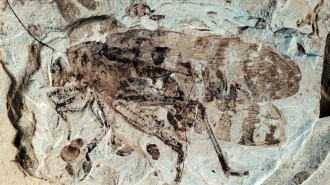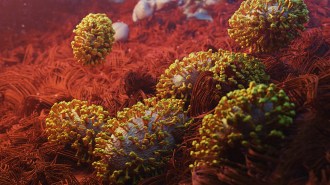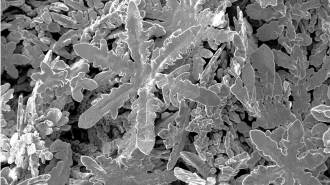All Stories
-
 Health & Medicine
Health & MedicineHow 4 major coronavirus tools impacted the pandemic in 2022
During the third year of the pandemic, young kids got vaccines, a new booster shot came along, the use of at-home tests soared and Paxlovid became widely available.
-
 Physics
PhysicsIn a breakthrough experiment, nuclear fusion finally makes more energy than it uses
The sun creates energy through nuclear fusion. Now scientists have too, in a controlled lab experiment, raising hopes for developing clean energy.
-
 Paleontology
PaleontologyKatydids had the earliest known insect ears 160 million years ago
Fossils from the Jurassic Period show katydid ears looked identical to those of modern katydids and could pick up short-range calls.
-
 Space
SpaceArtemis 1’s Orion capsule returned safely to Earth. What’s next?
The first test flight in NASA’s return to the moon Artemis program ended well with the uncrewed capsule splashing down in the Pacific Ocean.
By Liz Kruesi -
 Health & Medicine
Health & MedicineViruses other than the coronavirus made headlines in 2022
Here’s the latest on monkeypox, Ebola, bird flu and other outbreaks that hit this year.
-
 Health & Medicine
Health & MedicineHow much water should you drink a day? It depends on several factors.
A study of more than 5,000 people in 23 countries finds that individual water need varies widely depending on physical and environmental factors.
-

This was a year of both triumphs and challenges
Science News editor in chief Nancy Shute reviews the scientific advancements from the past year.
By Nancy Shute -
 Health & Medicine
Health & MedicineWhy pandemic fatigue and COVID-19 burnout took over in 2022
As public health guidelines loosened this year, people were left to weigh COVID-19 risks on their own. It was confusing, frustrating and exhausting.
-
 Physics
Physics50 years ago, physicists found the speed of light
In the 1970s, scientists set a new maximum speed limit for light. Fifty years later, they continue putting light through its paces.
By Nikk Ogasa -
 Health & Medicine
Health & MedicineBrief bursts of activity offer health benefits for people who don’t exercise
Non-exercisers who had brief bouts of vigorous day-to-day activity saw a reduced risk of death comparable to that of people who exercise regularly.
-
 Chemistry
ChemistryHow to make tiny metal snowflakes
In a pool of molten gallium, researchers grew symmetrical, hexagonal zinc nanostructures that resemble natural snowflakes.
By Nikk Ogasa -
 Math
MathThe metric system is growing. Here’s what you need to know
Science News spoke with a metrologist about the metric system’s latest update, which will help scientists interpret exceedingly big and small numbers.